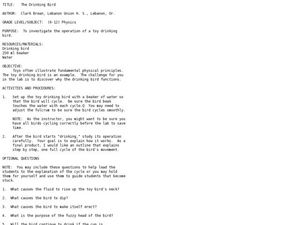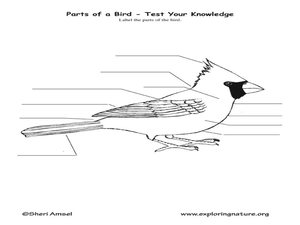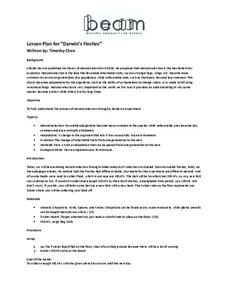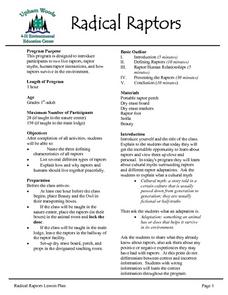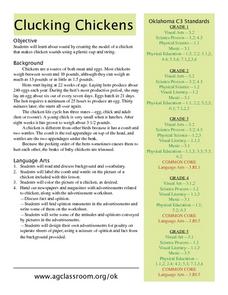Curated OER
Bird Break Buffet
Students discuss what human traits might help a person be more successful. They discuss how all birds are of the same species but have different beak traits. Students comprehend that the birds that eat the most food will have a baby with...
Curated OER
Bird Beak Buffet
Students complete an activity that allows them to better understand that birds traits are closely related to what they eat, where they live, etc. In this bird trait lesson students complete an activity, create a data board and graph the...
Curated OER
Bird Beak Anatomy
Third graders participate in an activity to determine which tool will work the best to gather food. They create analogies about how the experiment relates to birds. They brainstorm about which adaptation helps or hurts the survival of an...
Curated OER
Look Up - Birds
Students investigate the concept of birds. They identify five different types of birds and name the characteristics that make them different than other living things. Students also name the different parts of the bird and how they are...
Desert Discoveries
Bird and Feather Features
Ornithology is the study of birds, and young scientists do just that with an interesting science lesson. They identify the parts of a bird, realize that birds have different types of beaks, wings, and feet, and take a close look at bird...
Curated OER
Birds
In this birds worksheet, students review the characteristics of birds including their adaptations for flight. Students review the diversity of bird adaptations. This worksheet has 4 short answer, 7 true or false, 6 matching, and 3 fill...
Curated OER
Marine & Aquatic Habitats Activities - Estuaries Are for the Birds!
Students recognize that birds act as indicators of pollution because of their sensitivity to environmental change, and role play the manner in which marine debris can be hazardous to waterfowl.
Scholastic
Awesome Adaptations
Engaged learners discover how an owl beak works and how animals adapt to their environment. This task is part one of a three-part series.
Curated OER
Birds of Wisconsin
First graders explore the job done by ornithologists. They role play identifying the characteristics that make a bird a bird. They discuss what makes each bird species unique. Students are introduced to Wisconsin's most common and rare...
Curated OER
Compare Human-made Objects with Natural Objects
Students examine and observe how many human-made objects get their basic design from things in nature. They listen to the book "Nature Got There First," compare/contrast hollow bones with drinking straws, bird beaks and tool pliers, and...
Curated OER
Watch the Birdie
Students complete a six-week unit on North American birds. They conduct research, develop fact sheets, create labeled bird drawings, write a dictionary of bird vocabulary words, create a Concentration game, and observe birds in their...
Curated OER
The Drinking Bird
Students discover how the "drinking bird" functions. In this investigative lesson, students discover what makes the drinking bird drink by analyzing relative humidity, temperature, and barometric pressure.
Curated OER
The Drinking Bird
Students discover how toys often illustrate fundamental physical principles. The toy drinking bird is an example. The challenge for you in the lab is to discover why the drinking bird functions.
Curated OER
Learning Bird Traits
Students draw and label a bird. In this bird traits instructional activity, students learn what traits make a bird different from other animals. Students are taught how to draw a bird and are expected to label the various body parts they...
Curated OER
Classification of Organisms
In this classification worksheet, learners solve 3 classification riddles, complete 6 true and false questions, complete 4 sequences, and solve a riddle about the classification of an animal.
Polar Trec
Swan Savvy
Just like so many other birds, swans migrate during the cold winter months. Your class can gain a better understanding of migration and bird life as they act out some of the activities common to the tundra swan. They make a nest, sit on...
American Museum of Natural History
Beyond T. Rex
Some dinosaurs get all the attention. Pupils use an interactive resource to study some of the lesser-known dinosaur species. Organizing the information in a cladogram allows learners to make connections among the species.
Curated OER
Eeks Beaks
Seventh graders examine the concept of adaptations that take place in the wild. Birds are the focus organism for this study. They examine the beaks of different birds and point out the differentiations.
Curated OER
Best Nest Builders
Students construct a nest out of mud, string, sticks, and grass using only two fingers or two popsicle sticks to simulate a bird building a nest. They compare/contrast pictures of various bird nests and draw the differences between the...
Curated OER
The Amazing Woodpecker
In this woodpecker worksheet, students read a 1 page passage titled The Amazing Woodpecker and answer multiple choice questions about it. Students answer 5 questions.
Berkeley Engineering and Mentors
Darwin's Finches
Try a twist on the old finch beak and chopsticks activity by using M&Ms on a Twister mat. Spoons, knives, forks, and chopsticks represent beaks and are randomly assigned to your little birds, who must collect as much food as possible...
Curated OER
Radical Raptors
Students are introduced to raptors and their role in the environment. They identify three characteristics of raptors and list several types of raptors found in nature. They discuss their positive and negative experiences with raptors and...
Curated OER
The Living Environment
Young scholars use a spoon, clothespin, scissors, and toothpicks to simulate how animals get food in their environment. For this environment lesson plan, students learn about the adaptations animals make in order to survive.
Curated OER
Clucking Chickens
A comb, wattle, and beak are three characteristics that describe a chicken. Your class can explore the life of a chicken through reading, art, movement, and music. Using a plastic cup and string, they'll create a pretend chicken that...













